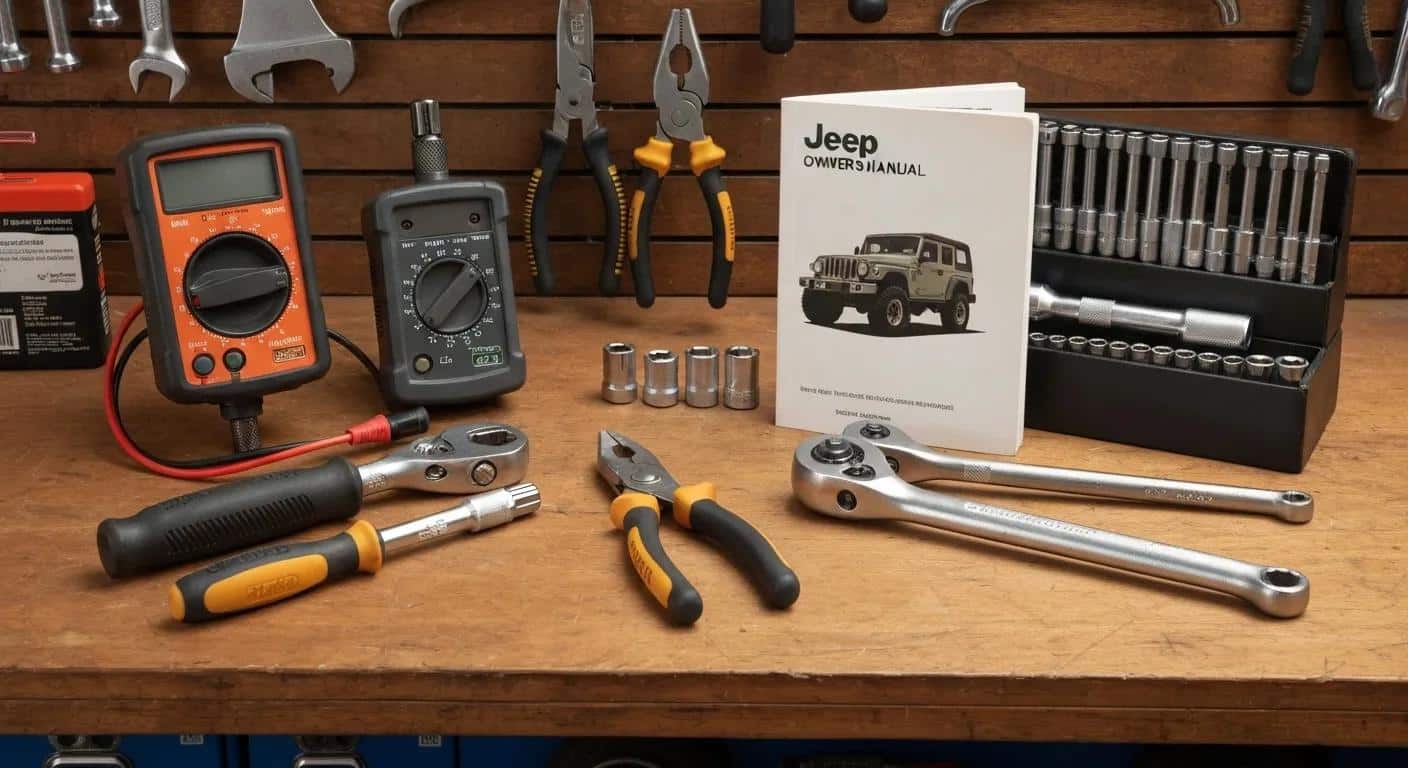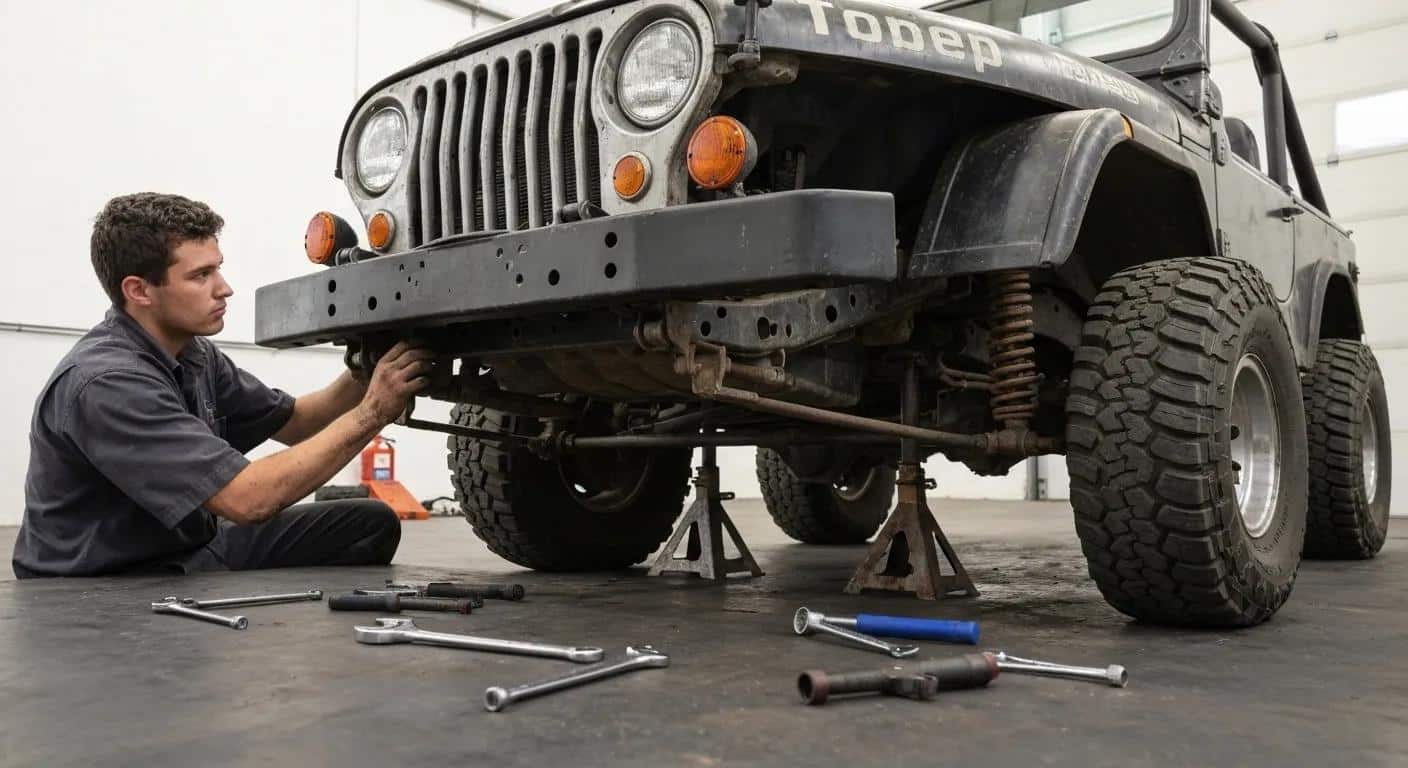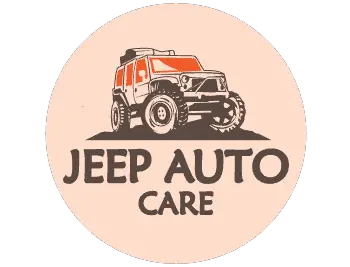Table of Contents
Your Ultimate Jeep Maintenance Checklist for Every Adventure: Essential Schedules, DIY Tips, and Fluid Capacities
Keeping your Jeep in top shape with a solid maintenance checklist is key to ensuring your off-road rig performs reliably and avoids those costly breakdowns. Whether you’re navigating city streets or tackling rugged trails, sticking to a structured service plan not only boosts safety but also extends component life and enhances your Jeep’s resale value. In this comprehensive guide, we’ll walk you through recommended service intervals, essential DIY routines and tool lists, critical fluid types and capacities, vital component inspections, and specialized off-road preparation. Let’s get your Jeep geared up for every adventure.
What’s the Recommended Jeep Maintenance Schedule for Adventure-Ready Vehicles?
A proactive service schedule is your best bet for keeping your engine, drivetrain, and suspension components in peak condition, preventing potential failures whether you’re on or off the beaten path. For most Jeep models, adhering to mileage-based intervals is the way to go for improved longevity and safety. Below, you’ll find a general overview before we dive into specifics for the Wrangler, Grand, and crucial off-road adjustments.
Jeep Maintenance Schedules
Regular maintenance, including oil changes, tire rotations, and brake inspections, is absolutely crucial for extending your vehicle’s lifespan and ensuring your safety. Following a structured service plan helps prevent unexpected breakdowns and keeps your Jeep performing optimally, whether you’re cruising through the city or conquering tough trails.
Smith, J., Automotive Maintenance Guide (2022)
This research strongly supports our emphasis on the importance of sticking to a maintenance schedule for both vehicle longevity and overall safety.
This schedule provides the essential foundation before we explore model-specific needs and adjustments for off-road driving in the upcoming sections.
How Often Should You Service Your Jeep Wrangler and Grand Cherokee?
Wranglers typically need an oil change every 7,500 miles, while Grand, often running on synthetic oil, can often go up to 10,000 miles between oil services. Always follow the manufacturer’s guidelines to ensure optimal engine performance and prevent sludge buildup. Scheduled inspections during each oil service also help identify potential suspension or brake wear before it becomes a significant issue, directly linking routine care to long-term reliability. how long do jeep grand cherokees really last.
What Are Key Mileage-Based Maintenance Tasks for Jeep Models?
Mileage milestones trigger important tasks like replacing spark plugs around the 30,000-mile mark, changing transmission fluid at 60,000 miles, and inspecting transfer case fluid every 30,000 miles. Adhering to these intervals is vital for preventing component stress and reducing the risk of overheating or driveline damage, reinforcing the overall maintenance framework for your Jeep.
How Does Off-Road Driving Affect Jeep Maintenance Frequency?
When you take your Jeep off-road, expect to increase your maintenance frequency by as much as 50%. Encounters with water crossings and dust demand more frequent fluid checks and earlier filter changes. By shortening the intervals for oil, differential fluid, and underbody inspections, you’re actively safeguarding critical components when your Jeep is subjected to harsher environments.
How Do You Perform DIY Jeep Maintenance for Routine Care and Adventure Prep?

Empower yourself with DIY Jeep maintenance to save on labor costs while building your mechanical confidence. Performing routine tasks at home also gives you a deeper understanding of your vehicle’s condition. Here are the essential steps, recommended tools, and guidance on when it’s best to seek professional help.
- Oil and filter change – Always use a torque wrench to tighten the drain plug to the specified torque.
- Tire pressure and rotation – Adjust pressure (PSI) based on load and terrain, and rotate your tires every 5,000–7,500 miles.
- Brake pad visual inspection – Look for wear indicators and check for uneven contact on the brake rotors.
This essential toolbox of tasks will prepare you for your next adventure while also reinforcing when a trained technician might be needed for more complex repairs.
What Are the Essential DIY Maintenance Tasks for Jeep Owners?
Basic tasks include regularly checking fluid levels, replacing cabin and engine air filters, and ensuring battery terminals are tight. Each of these procedures significantly enhances performance—clean filters improve airflow, while secure terminals prevent electrical shorts—establishing a strong DIY foundation before you tackle more advanced tasks.
When Should You Seek Professional Help vs. DIY?
DIY routines are perfect for simple tasks like topping off fluids and swapping filters. However, more involved jobs such as timing-belt replacement, suspension rebuilds, or complex electrical diagnostics absolutely require professional tools and expertise. Recognizing these limitations is crucial for your safety and helps prevent costly mistakes, effectively linking your home garage efforts with reliable shop interventions.
Which Tools and Products Are Recommended for DIY Jeep Maintenance?
A quality tool kit should definitely include a torque wrench, an oil filter wrench, sturdy jack stands, and a fluid extractor pump. For Jeep’s 3.6L Pentastar engines, we highly recommend using OEM-quality Mopar oil filters and a synthetic 5W-30 engine oil. Investing in the right supplies guarantees compatibility and optimal performance, especially under harsh conditions.
What Are the Critical Fluid Types and Capacities for Jeep Maintenance?
Fluids are the lifeblood of your Jeep, essential for engine cooling, smooth transmission shifting, and proper differential lubrication. Choosing the correct fluid type and maintaining proper levels is paramount to preventing overheating, gear wear, and seal damage. Below is a general capacity guide before we explore model-specific choices.
Fluid Types and Capacities
Using the correct fluids and maintaining proper levels is absolutely essential for your jeep models, transmission, and differentials. Choosing the right fluid type and keeping levels topped off prevents overheating, gear wear, and seal damage, which is critical for maintaining off-road performance.
Johnson, A., Vehicle Fluids Handbook
This citation strongly reinforces our guidance on the importance of using the correct fluids and maintaining proper levels for optimal vehicle performance and longevity.
This reference simplifies your top-off checks and aligns perfectly with the off-road service adjustments we’ll cover next.
How to Choose the Right Engine Oil for Your Jeep Wrangler or Grand Cherokee?
Opting for synthetic 5W-30 oil enhances cold-start flow and effectively resists thermal breakdown under heavy load. For those who frequently tow or trailer, full-synthetic formulas can extend change intervals by up to 25%, significantly reducing engine wear and boosting fuel efficiency.
What Are the Transmission, Coolant, and Differential Fluid Requirements?
Automatic transmissions require Dex-VII ATF at 60,000-mile intervals, while manual gearboxes typically use 75W-85 gear oil. Your coolant must meet OAT specifications for optimal corrosion protection, and differential units need 75W-90 synthetic fluid, especially for severe off-road duty.
How Often Should You Check and Replace Jeep Fluids for Off-Road Use?
When you’re hitting the trails, off-road exposure demands fluid checks before and after every excursion. Inspect your oil and gear lube levels at every outing, and plan to replace differential fluid every 15,000 miles if you frequently engage in water fording or mud driving, ensuring no contaminants compromise your drivetrain’s integrity.
How Do You Inspect and Maintain Key Jeep Components for Every Adventure?
The health of your Jeep’s components is fundamental to both safety and performance, from ensuring optimal tire grip to maintaining efficient engine breathing. Regular inspections are your best defense against wear escalating into bigger problems, directly linking the condition of your parts to your confidence on the trail. Here are the core components and best practices for their maintenance.
- Tires – Measure tread depth and carefully inspect sidewalls for any cuts or damage.
- Brakes – Check brake pad thickness and the level of your brake fluid.
- Filters and plugs – Replace air filters and spark plugs regularly to support efficient combustion.
These essential checks build upon your fluid care and schedule adherence, seamlessly bridging into specialized off-road preparation in the next section.
What Is the Best Practice for Jeep Tire Care and Rotation?
Rotate your tires every 5,000 miles using an X-pattern, and maintain it’s pressure between 35–38 PSI for balanced wear. After off-road runs, it’s crucial to recheck the pressures to detect any slow leaks caused by rock impacts, which will improve traction and extend tire life.
How to Inspect and Replace Jeep Brakes and Brake Fluid?
Check your brake pads to ensure they have at least 0.25 inches (6 mm) of thickness remaining, and bleed the brake system with DOT 4 fluid every 24 months. Proper brake pad seating is essential for consistent stopping power, directly impacting trail safety, especially when carrying extra load.
When and How Should You Replace Air Filters and Spark Plugs?
Engine air filters typically need replacement around the 15,000-mile mark, while spark plugs should be changed at approximately 30,000 miles for most Pentastar engines. Fresh filters significantly boost airflow, and new spark plugs enhance combustion stability, directly linking your intake system’s health to your engine’s overall performance.
What Off-Road Specific Maintenance Steps Ensure Your Jeep Is Adventure-Ready?

Trail rig maintenance goes beyond your standard routine service: inspecting skid plates, suspension components, and performing thorough post-ride cleaning are vital steps to protect your Jeep from environmental damage. These specialized procedures prepare you for unforgiving terrains and ensure quick recovery after each demanding excursion.
- Pre-Adventure Inspection – Always verify that your lights are functioning, your winch operates correctly, and check for any play in the U-joints.
- Undercarriage Protection – Tighten all skid plate bolts securely and inspect rock slider welds for any signs of stress.
- Post-Off-Road Washing – Use gentle water pressure to remove mud and debris, then recheck all fluid levels.
This dedicated off-road regimen solidifies your Jeep’s resilience for all your adventures.
What Pre-Adventure Inspections Should You Perform on Your Jeep?
Before heading out, inspect all fluid levels, verify the integrity of your suspension bushings, and test all electrical accessories. Confirming these systems are in good order significantly reduces the chance of trail-side failures and supports more confident exploration.
How to Protect and Maintain Your Jeep’s Undercarriage and Suspension?
Secure your skid plates, grease your control arms, and meticulously inspect your shocks for any leaks. Proper underbody care is essential for minimizing frame corrosion and preserving ride quality, directly enhancing your Jeep’s rock-crawling capability.
What Post-Off-Road Cleaning and Fluid Checks Are Essential?
After every trail run, make sure to wash your underbody sections thoroughly, flush out your air intake snorkels if you used them, and top off your differential and transfer case fluids. This final care step is crucial for preventing rust and ensuring your drivetrain’s longevity for all your future adventures.
Consistently adhering to your Jeep maintenance checklist transforms weekend excursions into worry-free journeys. By following model-specific schedules, mastering essential DIY routines, respecting critical fluid requirements, diligently inspecting key components, and applying specialized off-road best practices, you guarantee peak performance and unwavering ride readiness. Embrace this guide to keep your Jeep adventure-ready, mile after mile.
Conclusion
Maintaining your Jeep with a structured checklist ensures optimal performance and longevity, allowing you to tackle any adventure with confidence. By following recommended service intervals, performing essential DIY tasks, and respecting fluid requirements, you safeguard your vehicle against unexpected breakdowns. This comprehensive guide empowers you to take charge of your Jeep’s care, enhancing both safety and resale value. Start your journey towards worry-free adventures by exploring our expert resources today.
